
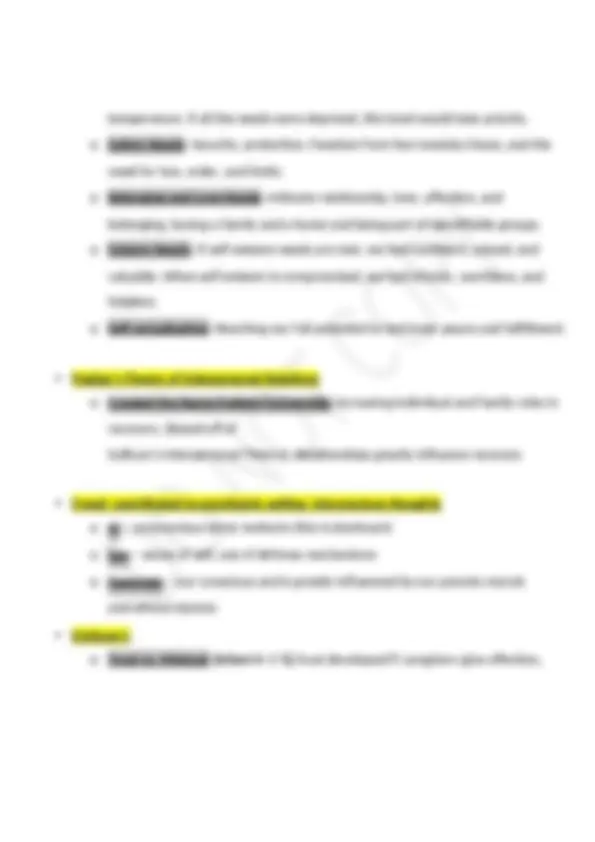
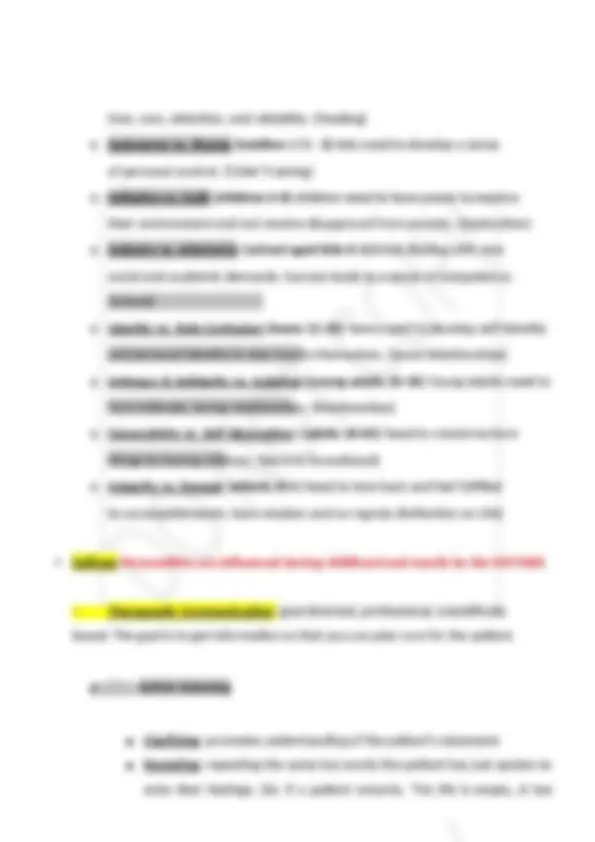
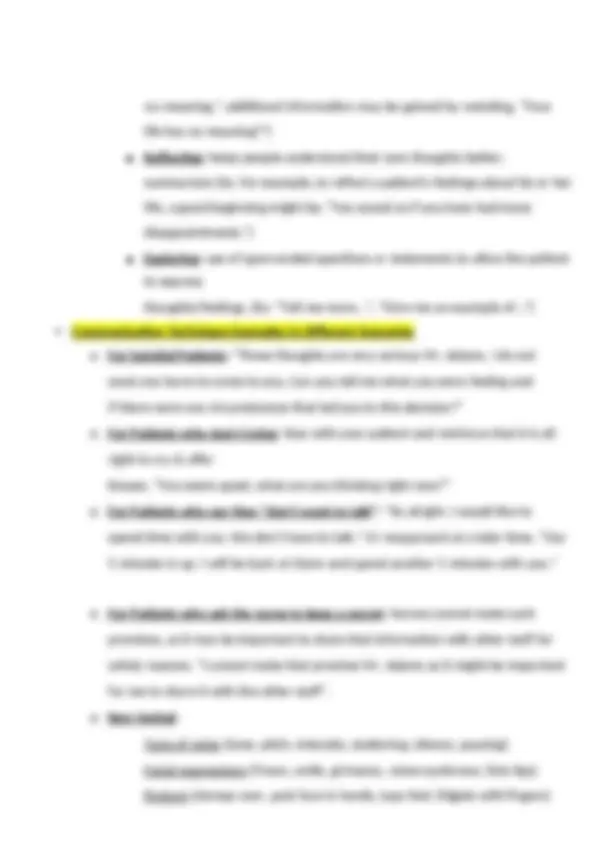
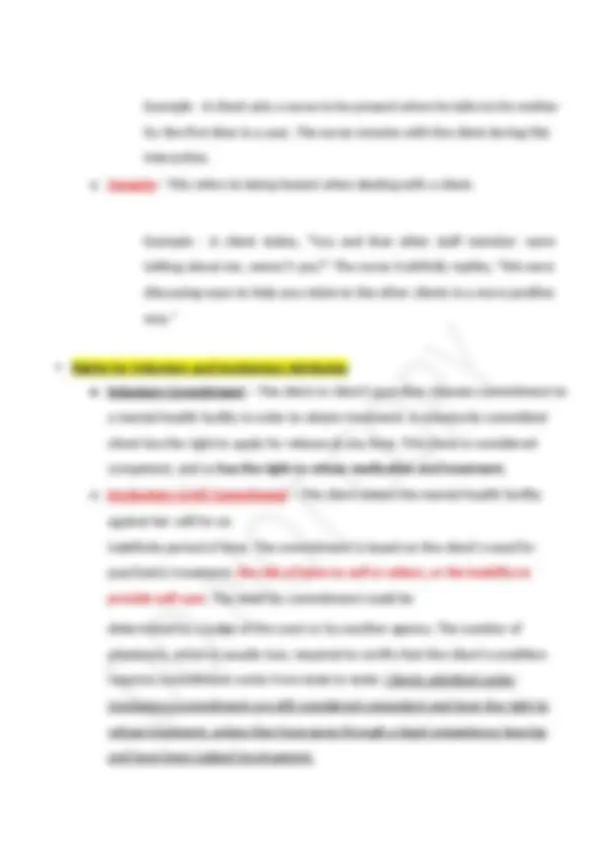

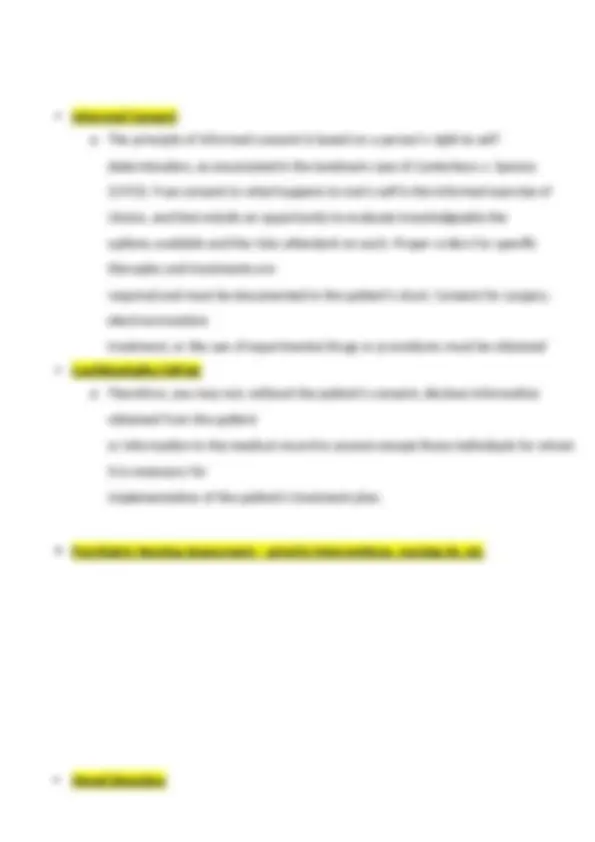
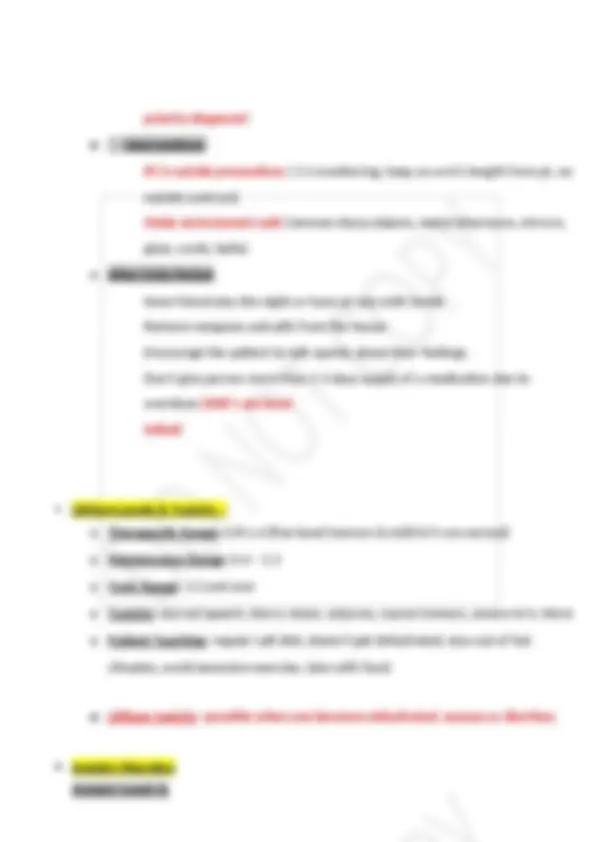
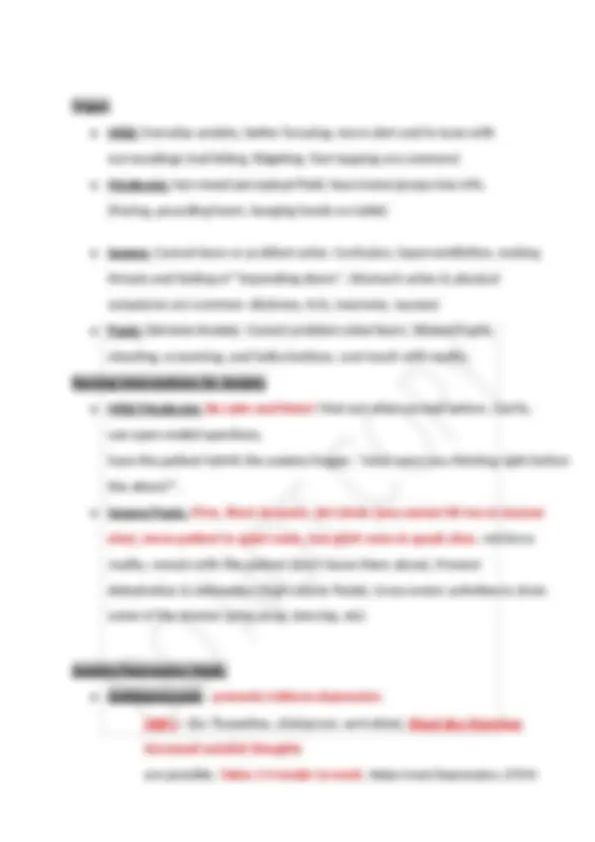
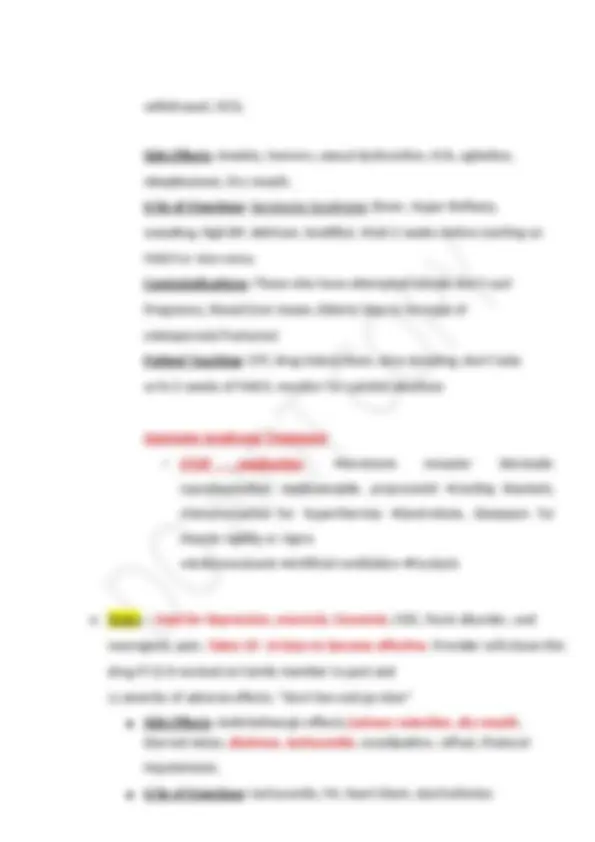
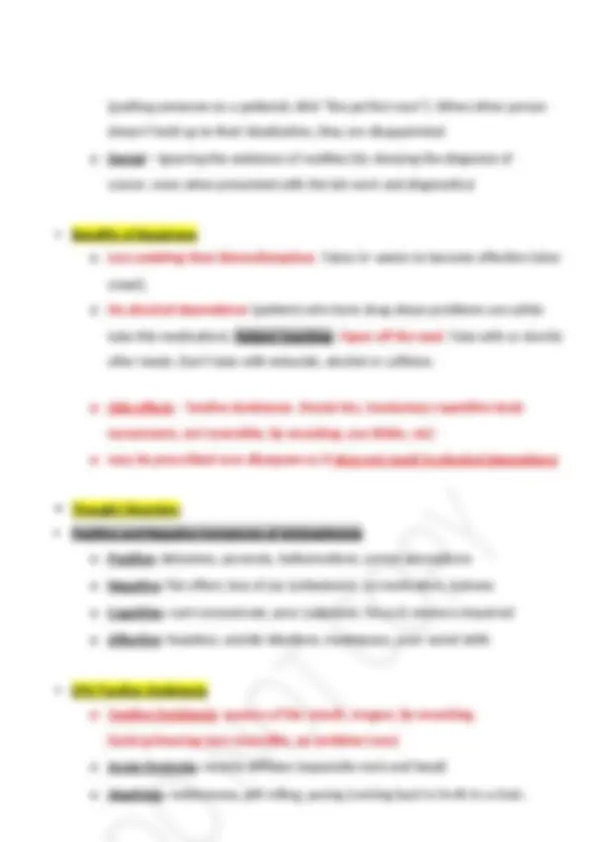

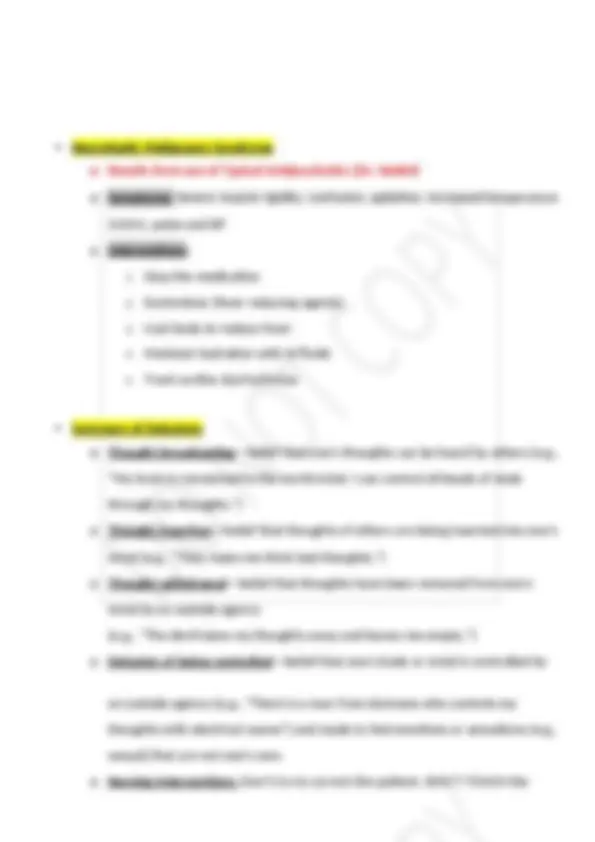
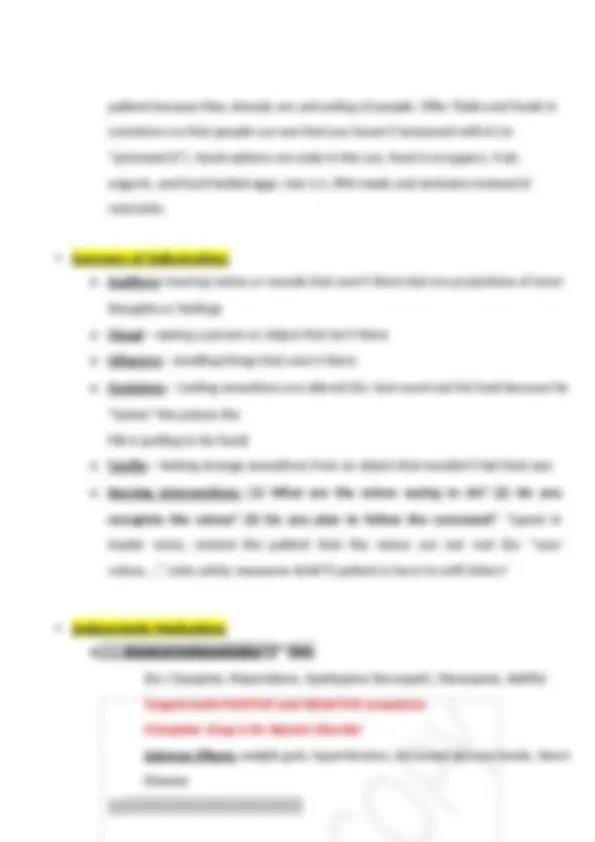
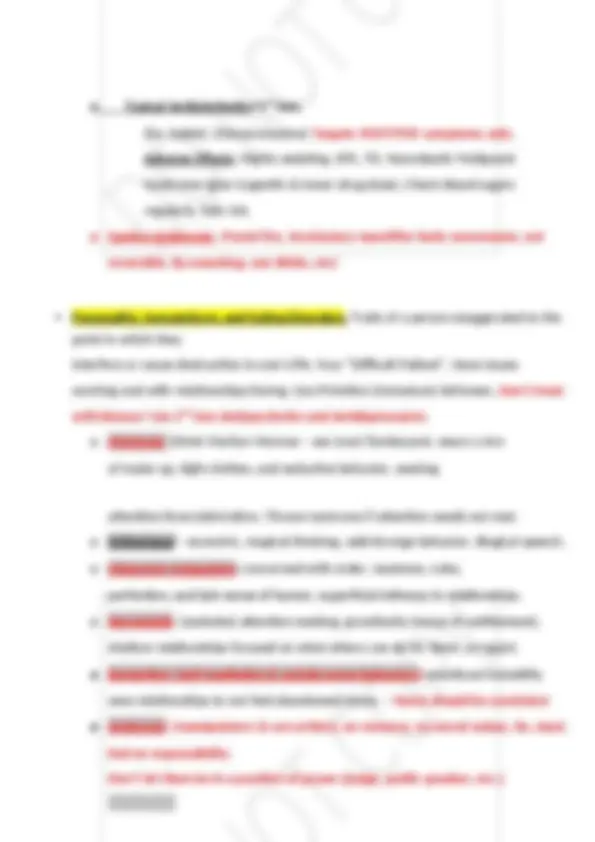
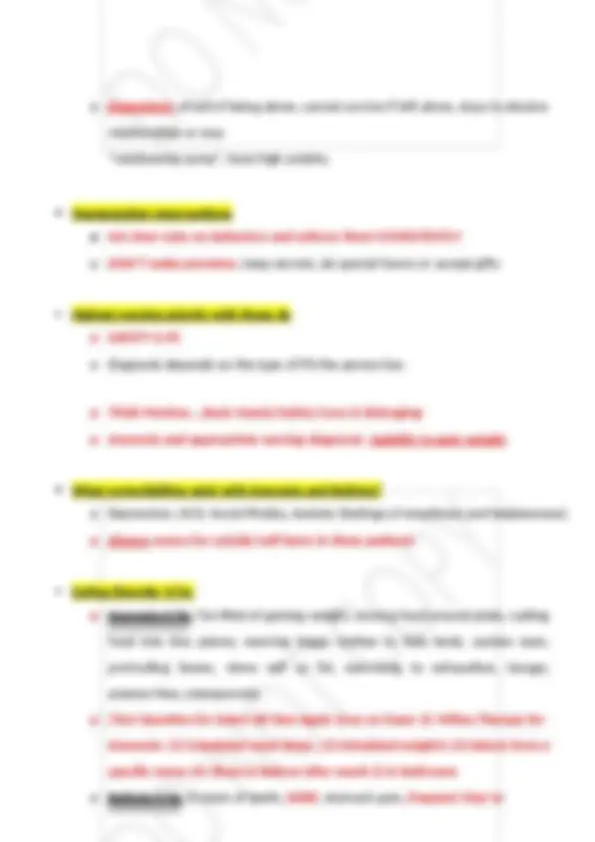
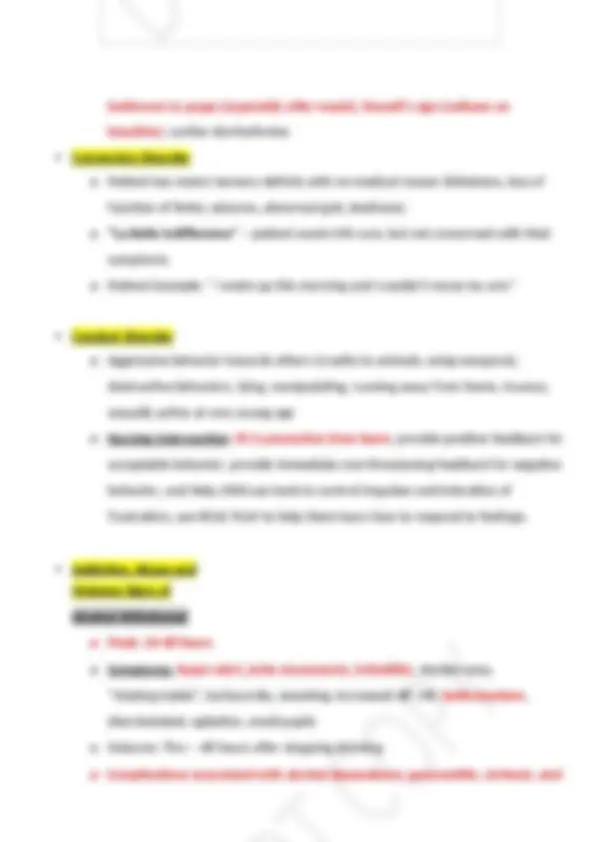
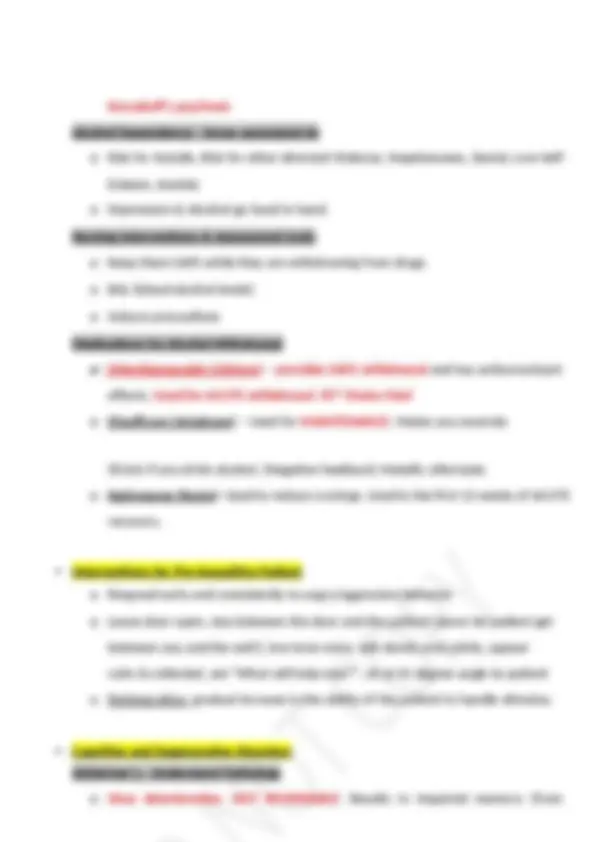
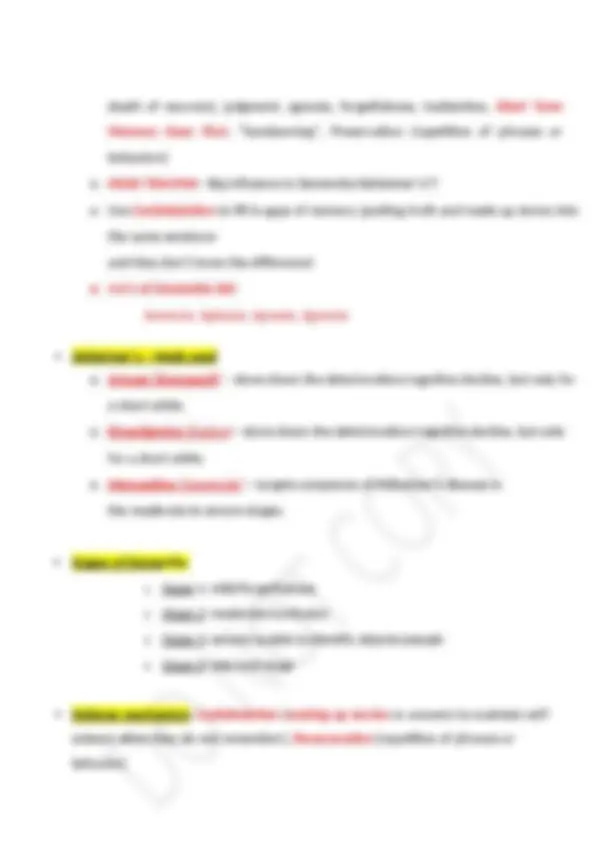
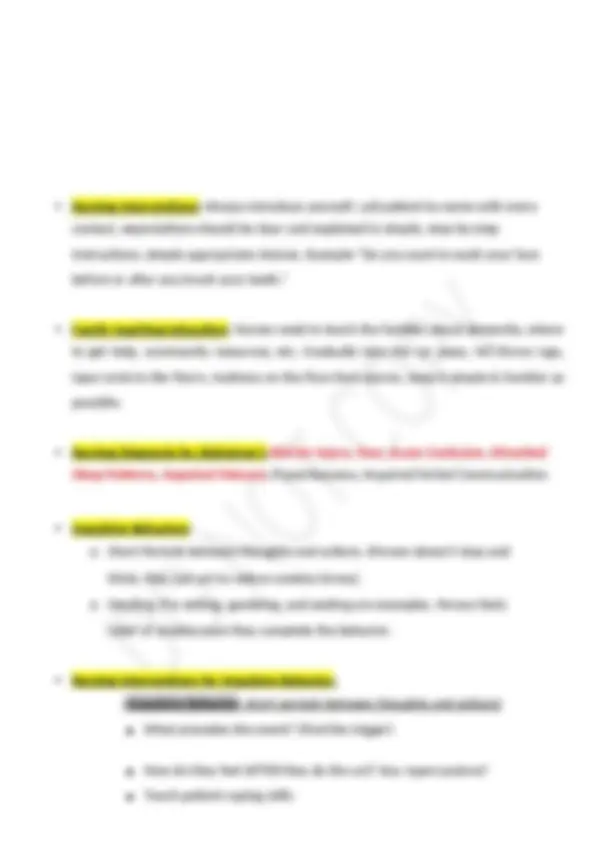
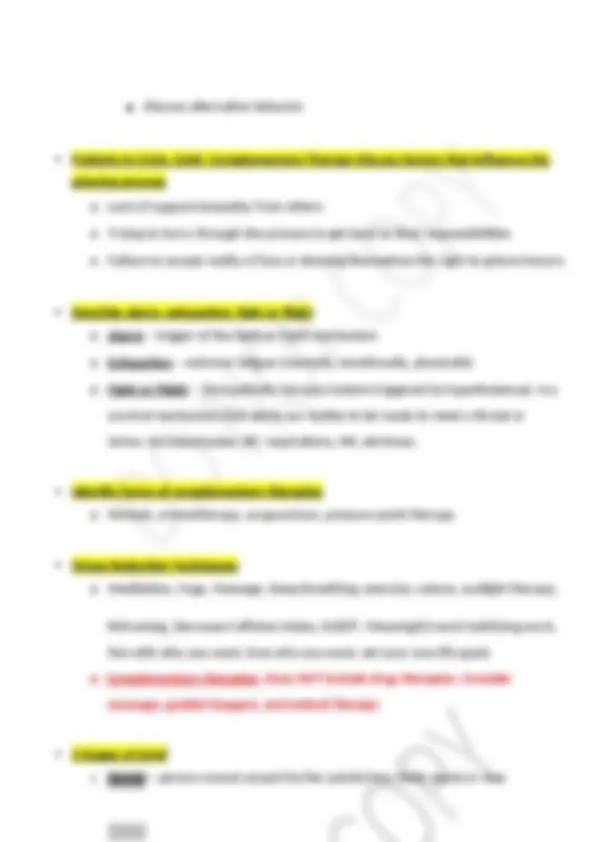
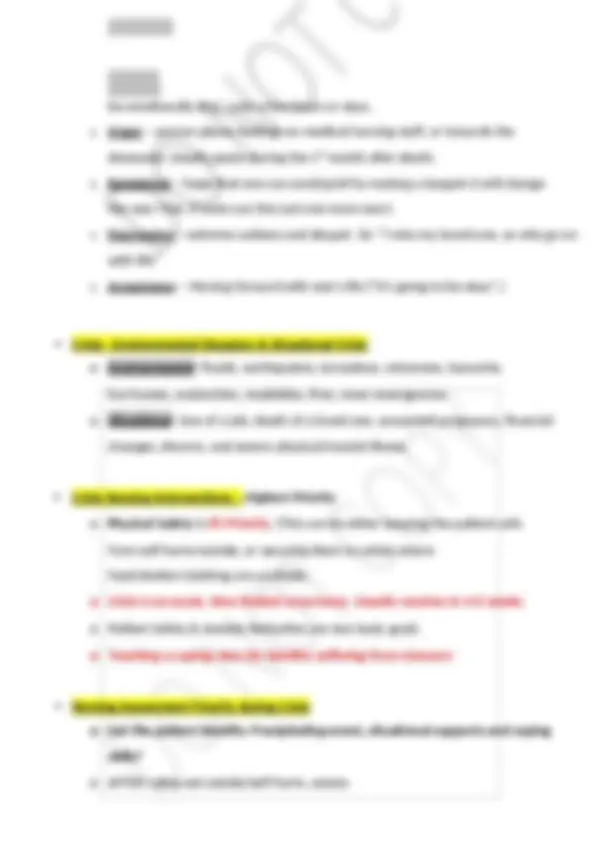

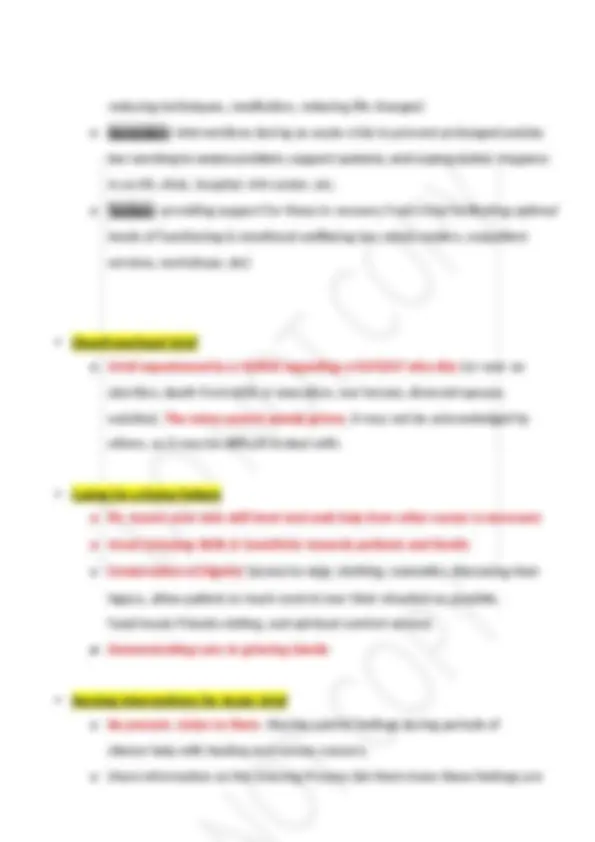
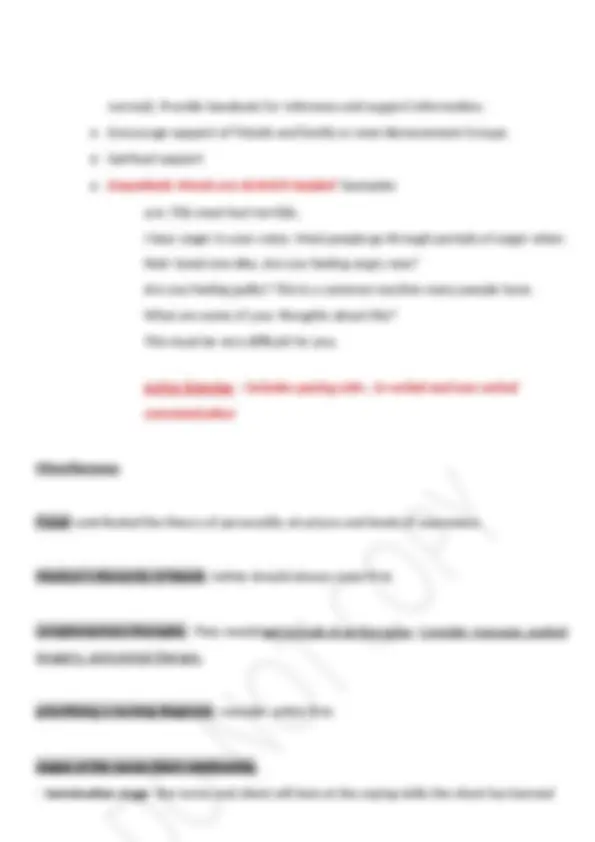
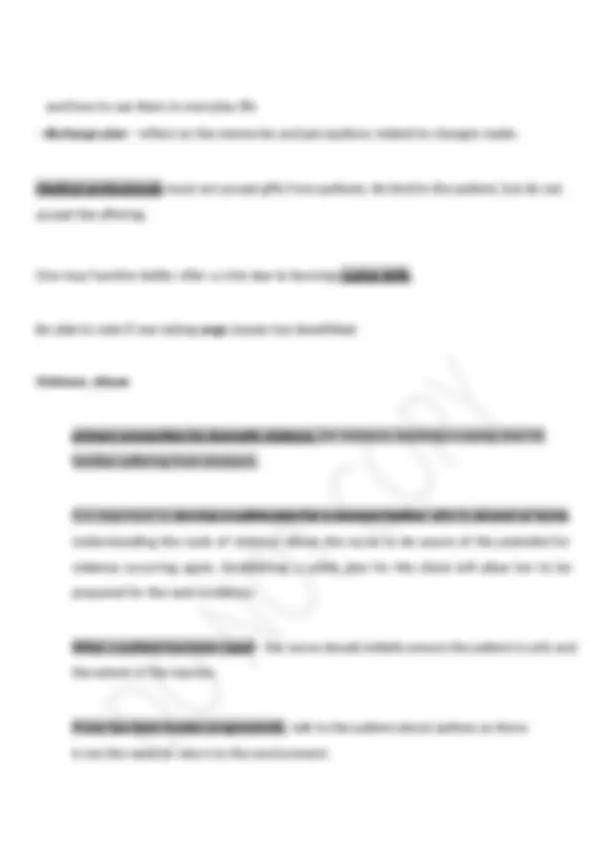

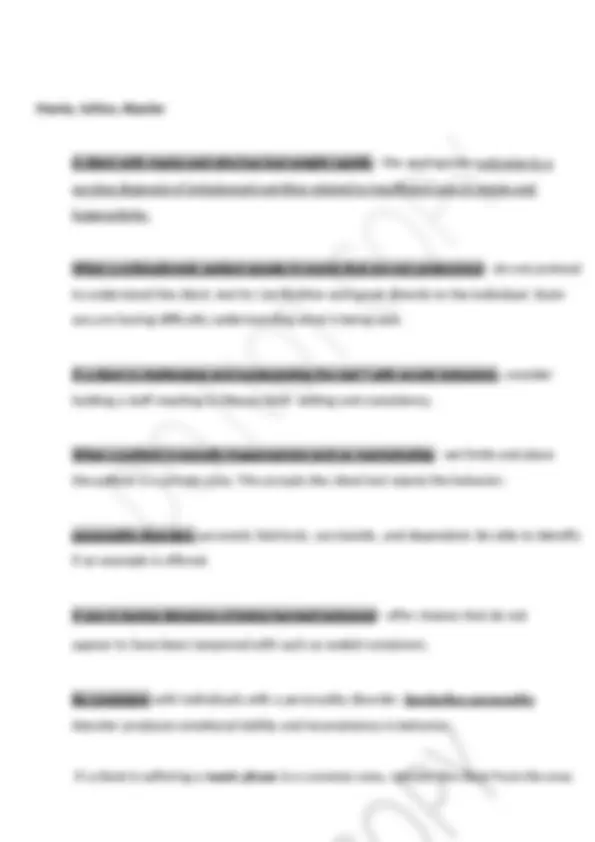
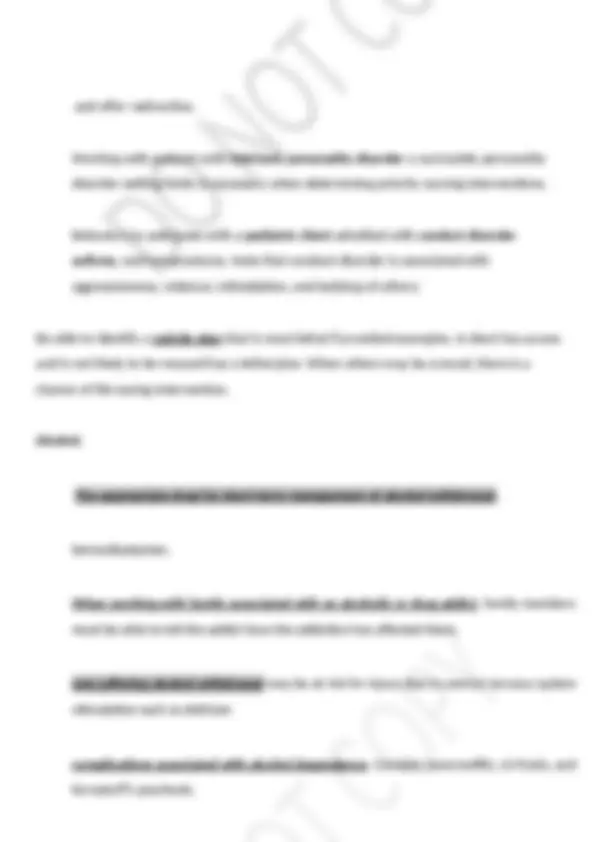
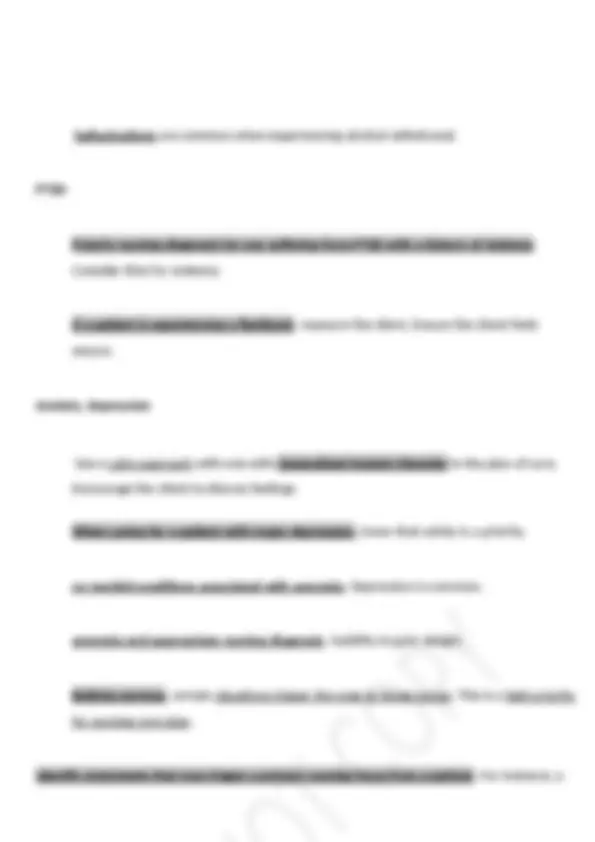
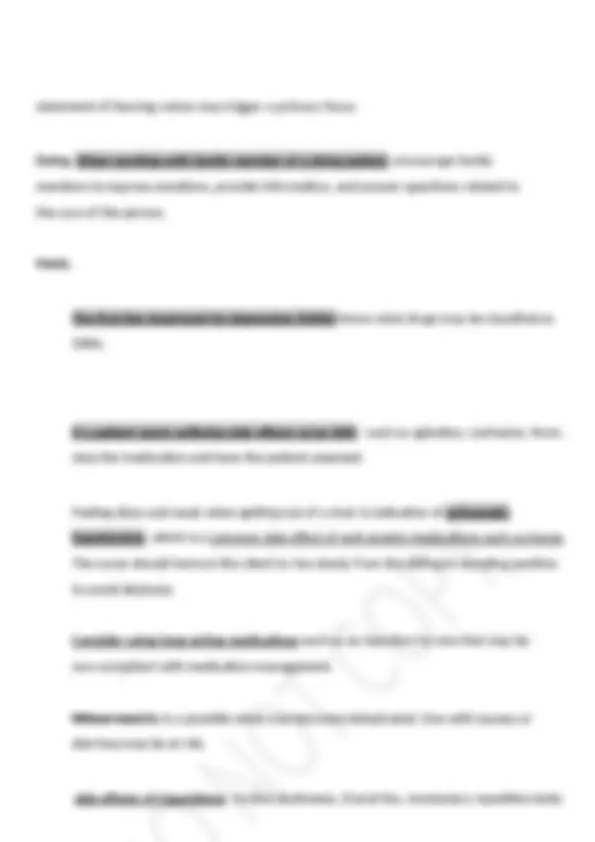
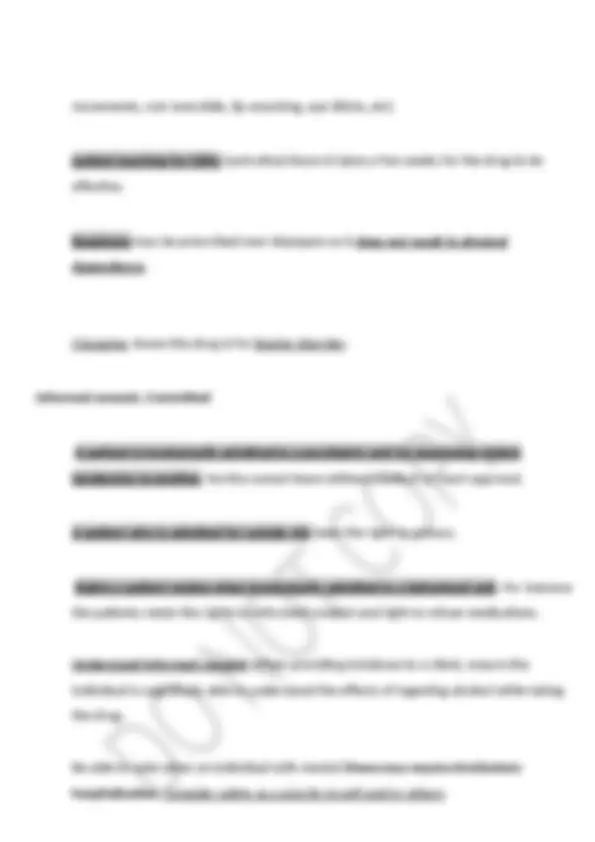
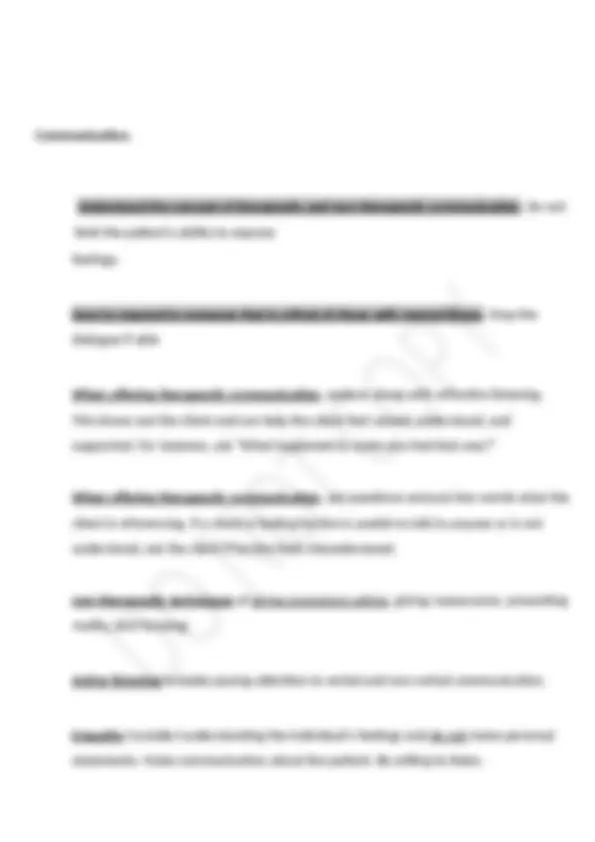
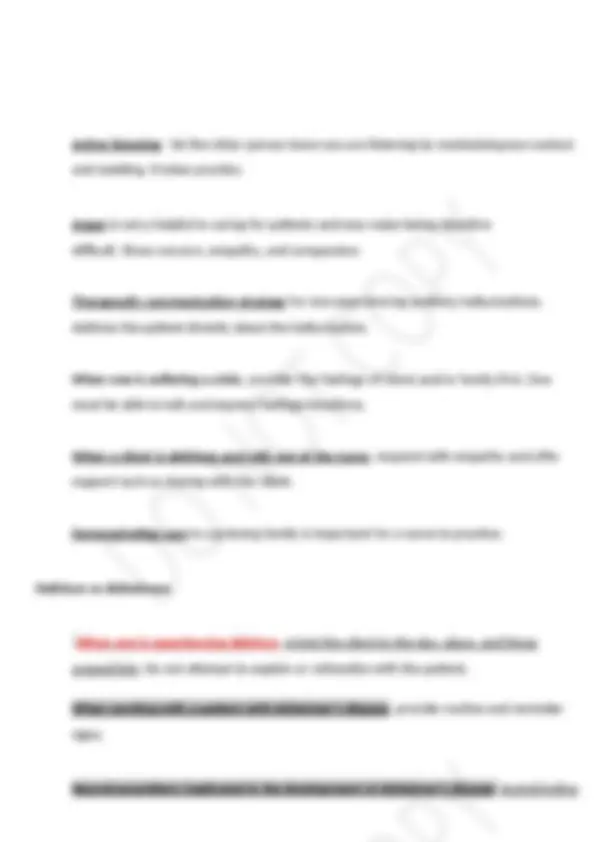
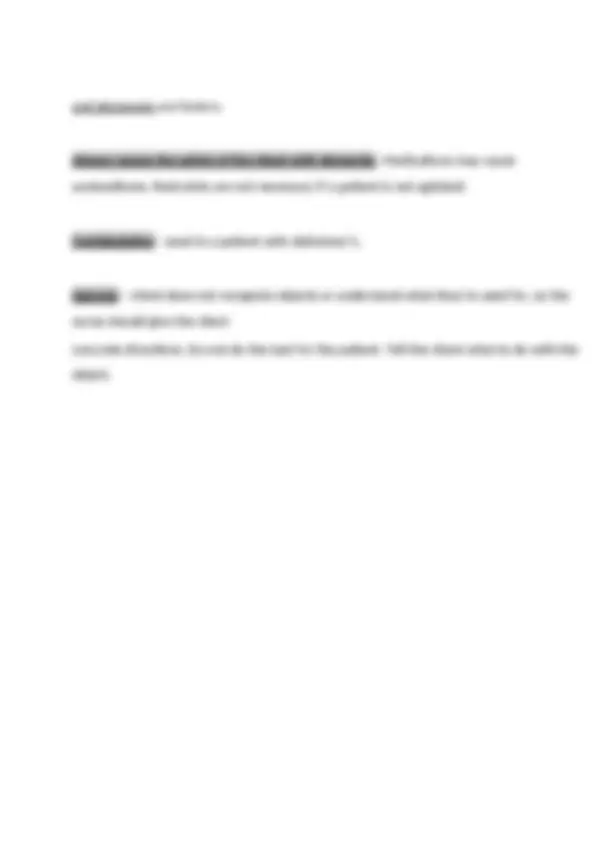


Study with the several resources on Docsity

Earn points by helping other students or get them with a premium plan


Prepare for your exams
Study with the several resources on Docsity

Earn points to download
Earn points by helping other students or get them with a premium plan
Community
Ask the community for help and clear up your study doubts
Discover the best universities in your country according to Docsity users
Free resources
Download our free guides on studying techniques, anxiety management strategies, and thesis advice from Docsity tutors
A study guide for the NUR 2488 Mental Health Exam. It covers topics such as evidence-based practice, the mental health recovery model, basic brain anatomy, milieu therapy, Maslow's hierarchy of needs, communication techniques, non-therapeutic communication, phases of the nurse-patient relationship, legal, ethical, and cultural considerations, informed consent, confidentiality/HIPAA, psychiatric nursing assessment, mood disorders, primary vs. secondary depression, borderline personality disorder, and nursing diagnoses for depression. It provides definitions, examples, and interventions for each topic.
Typology: Schemes and Mind Maps
1 / 42

This page cannot be seen from the preview
Don't miss anything!



































EBP (evidence based practice) Using the best available research evidence, clinical expertise, & patient preferences to make clinical decisions The 5 A’s of integrating best evidence into clinical practices includes : Asking The mental health recovery model is one of helping people with psychiatric disabilities effectively manage their symptoms, reduce psychosocial disability, and find a meaningful life in a community of their choosing. 3 specific areas are inherent within the art of nursing : caring, attending & patient advocacy
- Basic Brain Anatomy- what do the different part of brain control? o Frontal Lobe: Thought Processes & Voluntary Movement (decision making) o Temporal Lobe: Auditory Processes (language, speech, connects to Limbic system) o Occipital Lobe: Vision (interprets visual images) o Parietal Lobe: Sensory & Motor (L/R orientation, reading, math, proprioception) o Hypothalamus: maintains homeostasis, regulates BP, Temp, libido, hunger, thirst, and sleep/wake cycles. o Cerebellum: Balance, Skeletal Muscle Coordination o Neurons: Nerves that translate electrical impulses into chemical signals released at the synapse Synapse- The space between neurons in which neurotransmitters are released and either inhibit/excite the adjacent neuron. The 4 NT’s are dopamine, norepinephrine, serotonin and acetylcholine.
love, care, attention, and reliability. (Feeding) o Autonomy vs. Shame (toddlers 1 ½ - 3) kids need to develop a sense of personal control. (Toilet Training) o Initiative vs. Guilt (children 3-6) children need to have power to explore their environment and not receive disapproval from parents. (Exploration) o Industry vs. Inferiority: (school aged kids 6-12) Kids dealing with new social and academic demands. Success leads to a sense of competence. (School) o Identity vs. Role Confusion (teens 12-20) Teens need to develop self-identity and personal identity to stay true to themselves. (Social Relationships) o Intimacy & Solidarity vs. Isolation (young adults 20-30 ) Young Adults need to form intimate, loving relationships. (Relationships) o Generativity vs. Self-Absorption: (adults 30-65) Need to create/nurture things by having children. (Work & Parenthood) o Integrity vs. Despair (elderly 65+) Need to look back and feel fulfilled by accomplishments; have wisdom and no regrets (Reflection on Life)
no meaning,” additional information may be gained by restating, “Your life has no meaning?”) ▪ Reflecting: helps people understand their own thoughts better; summarizes (Ex: For example, to reflect a patient's feelings about his or her life, a good beginning might be, “You sound as if you have had many disappointments.”) ▪ Exploring: use of open-ended questions or statements to allow the patient to express thoughts/feelings. (Ex: “Tell me more…”, “Give me an example of…”)
strategies, evokes strong feelings in both client & nurse.
Example - A client asks a nurse to be present when he talks to his mother for the first time in a year. The nurse remains with the client during this interaction. o Veracity - This refers to being honest when dealing with a client. Example - A client states, “You and that other staff member were talking about me, weren’t you?” The nurse truthfully replies, “We were discussing ways to help you relate to the other clients in a more positive way.”
- Primary vs. Secondary Depression o Primary Depression : due to family history, female gender, 40yrs +, post- partum, chronic illness, ETOH abuse, stressful life events. o Secondary Depression: Resultant from another mental health disorder or debilitating chronic illness. Person is depressed BECAUSE of their decline in physical or mental functioning. - Borderline personality disorder - produces emotional lability and inconsistency in behavior. _ Nurse should be consistent with clients with a personality disorder_*
priority diagnosis! o Interventions: #1 is suicide precautions ( 1:1 monitoring, keep an arm’s length from pt, no suicide contract) Make environment safe (remove sharp objects, metal silverware, mirrors, glass, cords, belts) o After Crisis Period: Have friend stay the night or have pt stay with family Remove weapons and pills from the house Encourage the patient to talk openly about their feelings. Don’t give person more than 1-3 days supply of a medication due to overdose (SSRI’s are least lethal)
Stages o Mild: Everyday anxiety, better focusing, more alert and in-tune with surroundings (nail biting, fidgeting, foot tapping are common) o Moderate: Narrowed perceptual field, hears/sees/grasps less info. (Pacing, pounding heart, banging hands on table) o Severe: Cannot learn or problem solve. Confusion, hyperventilation, making threats and feeling of “impending doom”. (Stomach aches & physical symptoms are common: dizziness, H/A, insomnia, nausea) o Panic: Extreme Anxiety. Cannot problem solve/learn, Dilated Pupils, shouting, screaming, and hallucinations. Lost touch with reality. Nursing Interventions for Anxiety o Mild/Moderate: Be calm and listen! Find out what worked before. Clarify, use open-ended questions, have the patient NAME the anxiety/trigger, “what were you thinking right before the attack?”. o Severe/Panic: Firm, Short Answers, Set Limits (you cannot hit me or anyone else), move patient to quiet room, low pitch voice & speak slow, reinforce reality, remain with the patient (don’t leave them alone), Prevent dehydration & exhaustion (high calorie fluids). Gross motor activities to drain some of the tension (ping pong, dancing, etc) Anxiety/Depression Meds: o Antidepressants - prevents/relieves depression. SSRI’s – (Ex: fluoxetine, citalopram, sertraline). Black Box Warning: increased suicidal thoughts are possible. Takes 2-4 weeks to work. Helps treat Depression, ETOH
▪ Contraindications: Elderly and those with Cardiac Disease ▪ Patient Teaching: takes 6-8 for full effect, get up slowly from sitting position, take at BEDTIME to reduce side effects, good mouth care/lozenges for dry mouth, don’t stop cold turkey o MAOI –. (ex: Phenelzine/Nardil, Isocarboxazid, Parnate) Side Effects: insomnia, palpitations, H/A, loss of libido, Orthostatic Hypotension Contraindications: Foods with Tyramine (causes Hypertensive Crisis. Food Ex: avocados, figs, bananas, smoked meats, organs, lunch meat, yeast, aged cheese, beer/wine, smoked fish, soy sauce), Pregnancy!!! Patient Teaching: Hypotension is HUGE – get up slowly from sitting, avoid Tyramine foods, avoid cold medications, go to ER if pounding H/A, avoid eating at Chinese restaurants.
- Benzodiazepines – commonly given & teaching needed for patients o (Ex: Alprazolam, Diazepam, Lorazepam)(“Pam and Lam sisters”) o Very sedating, quick onset o Dependence on meds is HUGE. Don’t use a Benzo with a patient who has a history of drug abuse. Adverse Reactions: sedation, dry mouth, decreased cognitive function. Patient Teaching: increase fluids for dry mouth, don’t take if breastfeeding or if you have a drug abuse problem (ETOH too). Taper off the med. Take with or shortly after meals. Don’t take with Antacids, alcohol or caffeine.
- Defense Mechanisms o Altruism – emotional conflict are addressed by meeting the needs of others. o Sublimation – substituting something constructive for something they feel they lack or are inadequate at o Suppression – denial of something disturbing o Repression – forgetting/excluding unpleasant things from memory (forgetting a death of a parent, etc) o Displacement – transferring feelings from a particular person/event to something non-threatening (Boss yells at man man yells at wife wife yells at child child kicks the dog). o Undoing – compensation for a negative action, common in OCD (Ex: giving a gift to undo an argument. Washing hands frequently to reduce anxiety about dirty thoughts). o Somatization – turning anxiety into physical symptoms o Dissociation – the pain/anxiety is too much to deal with, so the patient dissociates to get away from it (an “out of body” experience). o Projection – blaming another PERSON for your own issues o Reaction Formation – unacceptable feelings are kept out of awareness by doing the opposite behavior (Ex: person who doesn’t like children becomes a boy scout leader) o Passive Aggressive – aggression towards others is expressed by procrastination, failure, and illness that affect others more than themselves. o Splitting – qualities of a person are either all good, or all bad – not a healthy mix. (either good, loving, nurturing or bad, mean, hateful). o Idealization – emotional issues are dealt with by exaggerated qualities to others
shifting weight from side to side)